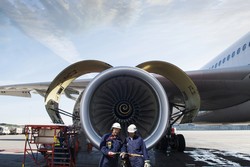New superalloys for high-efficiency jet engines
Temperatures inside aircraft engines may exceed the melting point of the metals, yet they do not become liquid thanks to the excellent properties of some materials. Combining mechanical strength, resistance to thermal creep deformation, good surface stability, and resistance to corrosion or oxidation, superalloys are typically defined as alloys designed for elevated temperatures. Just like any other material, superalloy properties are strongly influenced by their microstructure, which is in turn determined by the composition and processing that they have undergone. In the EU-funded project NECTAR (New generation of NiAl-based eutectic composites with tuneable properties), scientists conducted further studies on composites based on nickel-aluminide (NiAl) superalloys by merging state-of-the-art computational thermodynamics and advanced design and processing concepts. At their eutectic point, the various components of a mixture are in different phases – liquid phase, alpha phase and beta phase – which all exist in equilibrium. Focus was placed on the compositions of a mixture containing four components such as nickel, aluminium, chromium, tungsten, rhenium and vanadium. Having collected all experimental information on the quaternary phase diagrams and thermodynamic properties of each phase, scientists created thermodynamic databases for the three phases of the different possible quaternary systems. After selecting two eutectic systems, the team developed structural maps and defined the composition of the phases. Diffusion and phase-field models were developed to model the solidification process of the eutectic alloys. In addition, scientists modelled the microstructure, growth morphology, regularity and uniformity of the eutectic systems. Finally, the team described temperature dependence of mechanical properties as a function of volume fraction of the reinforcing phase, fracture toughness and failure mechanisms, as well as the creep properties of the eutectic systems. Alloys with lower fibre volume fraction were found to have better strength and creep resistance, whereas alloys with higher volume fraction proved to be more ductile and have better fracture toughness. NECTAR targeted a new generation of composites based on NiAl with tuneable properties with better performance than state-of-the-art nickel-based alloys that can stand temperatures above 1 150 °C, which jet engines typically reach.







